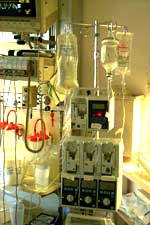Intravenous (IV) Fluids
What are IV fluids?
Intravenous fluids are sterile solutions similar to the liquid part of the blood. Many types of IV fluids are made for use in various types of illnesses and injuries.
Why are IV fluids used?
Many critically ill patients have decreased body fluids (dehydration) or inadequate fluid circulating in the blood stream. Intravenous fluids help to restore body fluids and circulating blood volume.
Do IV fluids hurt?
Placement of an IV catheter may sting but use of IV fluids usually does not hurt. Sometimes special nutrients or medications are added to the IV fluid. A few of these may burn or hurt when infused. Potassium is an example. The nurse closely monitors infusing IV fluids to prevent any pain from occurring. Sometimes an IV catheter comes out of the vein and IV fluid may be infused under the skin. Patients usually complain of swelling and discomfort if this occurs.
How long are IV fluids used?
Intravenous fluids are used as long as the patient's body fluids or blood volume is low. Even after dehydration is corrected and circulation is restored most ICU patients have an IV with fluids going in at a slow rate.
Are there any potential complications associated with IV fluids?
Edema (swelling) may occur when IV fluids are given. Edema is very common in the ICU and does not usually harm the patient. Edema goes away quickly in some patients and very slowly in others. Occasionally electrolyte imbalance occurs when patients are receiving IV fluids.
 Various types of intravenous (IV) fluids are shown.
Some IV fluids are in plastic bags and some are in glass bottles. The rate of IV fluid administration is
controlled by the infusion pumps shown toward the bottom of the picture.
Various types of intravenous (IV) fluids are shown.
Some IV fluids are in plastic bags and some are in glass bottles. The rate of IV fluid administration is
controlled by the infusion pumps shown toward the bottom of the picture.